Input interpretation

sulfur trioxide
Chemical names and formulas
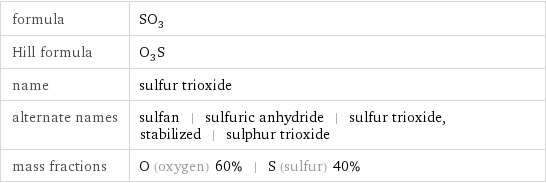
formula | SO_3 Hill formula | O_3S name | sulfur trioxide alternate names | sulfan | sulfuric anhydride | sulfur trioxide, stabilized | sulphur trioxide mass fractions | O (oxygen) 60% | S (sulfur) 40%
Lewis structure
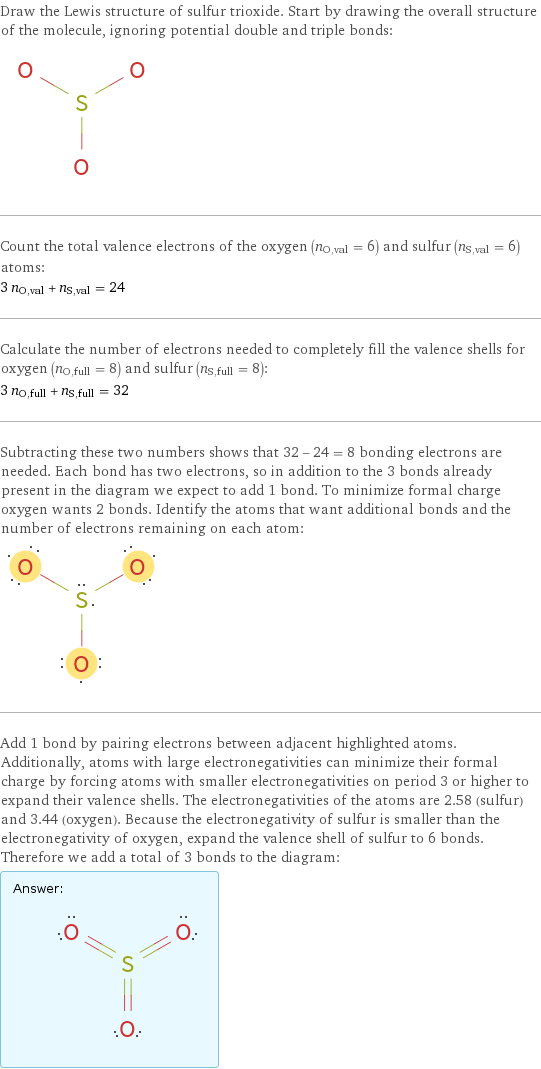
Draw the Lewis structure of sulfur trioxide. Start by drawing the overall structure of the molecule, ignoring potential double and triple bonds: Count the total valence electrons of the oxygen (n_O, val = 6) and sulfur (n_S, val = 6) atoms: 3 n_O, val + n_S, val = 24 Calculate the number of electrons needed to completely fill the valence shells for oxygen (n_O, full = 8) and sulfur (n_S, full = 8): 3 n_O, full + n_S, full = 32 Subtracting these two numbers shows that 32 - 24 = 8 bonding electrons are needed. Each bond has two electrons, so in addition to the 3 bonds already present in the diagram we expect to add 1 bond. To minimize formal charge oxygen wants 2 bonds. Identify the atoms that want additional bonds and the number of electrons remaining on each atom: Add 1 bond by pairing electrons between adjacent highlighted atoms. Additionally, atoms with large electronegativities can minimize their formal charge by forcing atoms with smaller electronegativities on period 3 or higher to expand their valence shells. The electronegativities of the atoms are 2.58 (sulfur) and 3.44 (oxygen). Because the electronegativity of sulfur is smaller than the electronegativity of oxygen, expand the valence shell of sulfur to 6 bonds. Therefore we add a total of 3 bonds to the diagram: Answer: | |
3D structure

3D structure
Basic properties
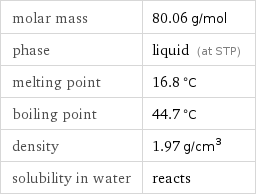
molar mass | 80.06 g/mol phase | liquid (at STP) melting point | 16.8 °C boiling point | 44.7 °C density | 1.97 g/cm^3 solubility in water | reacts
Units

Liquid properties (at STP)

density | 1.97 g/cm^3 vapor pressure | 280 mmHg dynamic viscosity | 0.00159 Pa s (at 30 °C)
Units

Thermodynamic properties
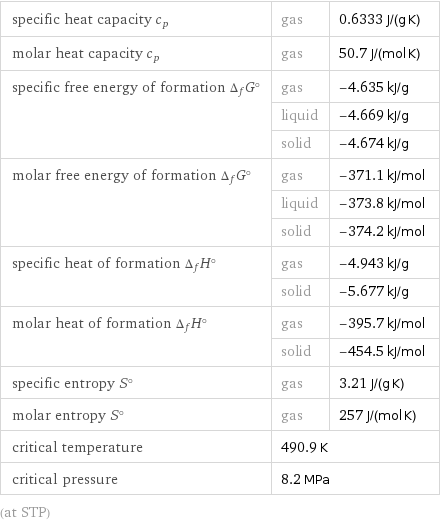
specific heat capacity c_p | gas | 0.6333 J/(g K) molar heat capacity c_p | gas | 50.7 J/(mol K) specific free energy of formation Δ_fG° | gas | -4.635 kJ/g | liquid | -4.669 kJ/g | solid | -4.674 kJ/g molar free energy of formation Δ_fG° | gas | -371.1 kJ/mol | liquid | -373.8 kJ/mol | solid | -374.2 kJ/mol specific heat of formation Δ_fH° | gas | -4.943 kJ/g | solid | -5.677 kJ/g molar heat of formation Δ_fH° | gas | -395.7 kJ/mol | solid | -454.5 kJ/mol specific entropy S° | gas | 3.21 J/(g K) molar entropy S° | gas | 257 J/(mol K) critical temperature | 490.9 K | critical pressure | 8.2 MPa | (at STP)
Chemical identifiers
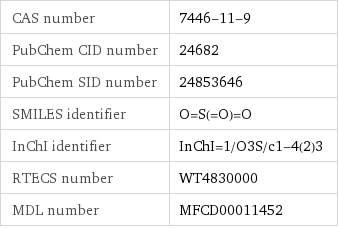
CAS number | 7446-11-9 PubChem CID number | 24682 PubChem SID number | 24853646 SMILES identifier | O=S(=O)=O InChI identifier | InChI=1/O3S/c1-4(2)3 RTECS number | WT4830000 MDL number | MFCD00011452
NFPA label

NFPA label
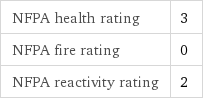
NFPA health rating | 3 NFPA fire rating | 0 NFPA reactivity rating | 2
Toxicity properties

RTECS classes | tumorigen | human data